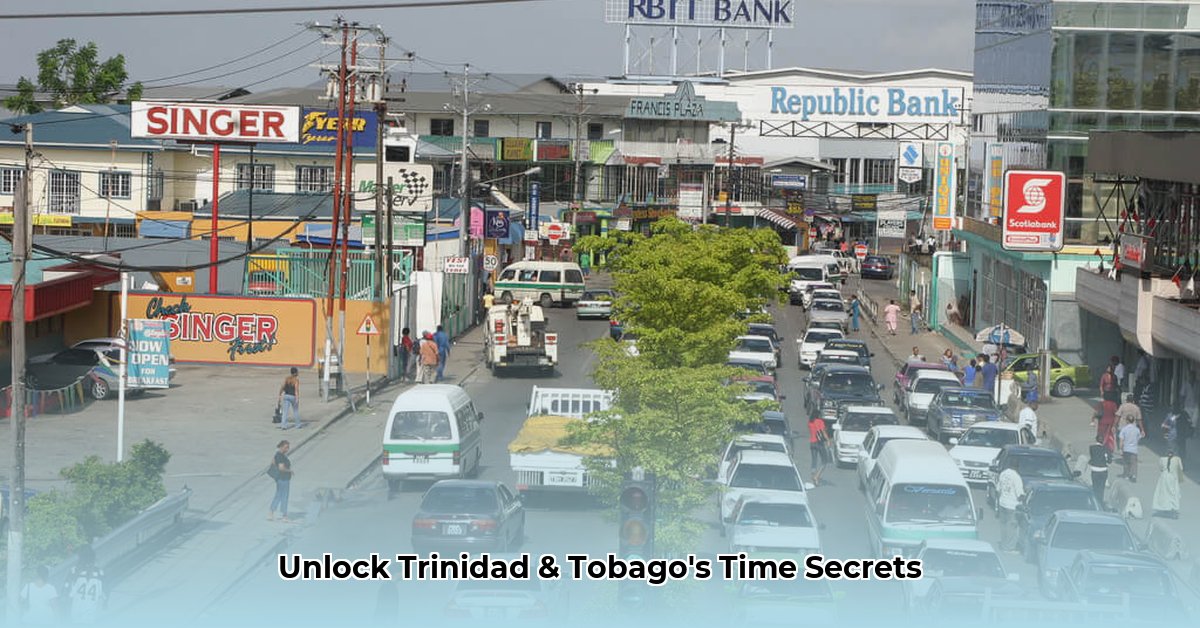Ever wondered what time it is in Trinidad and Tobago? It’s more than just knowing the hours; it’s about understanding the islands’ unique relationship with time. This article will clarify everything you need to know about timekeeping in this Caribbean nation, from the basics of its time zone to why it doesn’t change its clocks for daylight saving. We’ll make it easy to understand, with simple explanations and real-world examples, so whether you’re planning a vacation or working with businesses there, you’ll be a *time-zone* pro in no time. For more detailed information, check out this helpful resource: [Trinidad time](https://www.lolaapp.com/time-in-trinidad/).
Decoding Trinidad and Tobago Time Zone
Let’s talk about time in Trinidad and Tobago – it’s simpler than you might think! Unlike many places that switch clocks for daylight saving time, Trinidad and Tobago keeps it consistent all year round. This means no confusing spring-forward, fall-back shenanigans; your watch stays the same. This steady timekeeping is part of the islands’ relaxed vibe, a comforting constant in everyday life.
Island’s Consistent Time: Atlantic Standard Time (AST) Explained
Trinidad and Tobago uses Atlantic Standard Time (AST), which is four hours behind Coordinated Universal Time (UTC). Imagine it like this: when it’s lunchtime in London (UTC), it’s breakfast time in Port of Spain. This simple, unchanging system makes scheduling appointments, meetings, and even just coordinating with family and friends much easier. No more mental gymnastics trying to figure out if you need to add or subtract an hour! How much easier would international business be if everyone stuck to a single time zone?
The consistent time zone also plays a significant role in various aspects of life on the islands. For businesses, especially those in tourism, it provides a straightforward system for managing bookings and communications. International collaborations and remote work are simpler to manage because everyone knows exactly where they stand in relation to the local time. This predictability supports sectors relying on precise timing, such as aviation and shipping.
Delving into No Daylight Saving Time: History, Culture & Latitude Unveiled
You might wonder why Trinidad and Tobago doesn’t participate in daylight saving time (DST), like many other nations. The answer isn’t a single, simple reason. Instead, it’s a blend of historical factors, geographical considerations, cultural preferences, and practical considerations. Given Trinidad and Tobago’s proximity to the equator, the variance in daylight hours throughout the year is minimal, reducing the potential benefits of DST.
The decision to remain on AST dates back to 1945. Some believe that the potential energy savings from DST never outweighed the disruptions it might cause. There’s no widespread public demand for a change, suggesting that the existing system works well for the population. Others point to the islands’ generally relaxed pace of life, suggesting that the twice-yearly clock changes would be more of a hassle than a benefit. The prevailing view, at least for now, is that the benefits of the predictable and consistent AST system outweigh any potential drawbacks. The government’s stance prioritizes a constant, uncomplicated timetable. Imagine the logistical complications for schools and transport systems if DST were implemented!
It’s worth noting that ongoing research into energy consumption might eventually influence future decisions. Some experts believe further analysis is needed to definitively assess the actual impact of not using DST on energy consumption. This ongoing discussion means opinions and potential future adjustments remain on the table. Perhaps future studies focusing on the impact on specific industries, such as agriculture, could offer more nuanced insights.
Navigating Trinidad and Tobago Time: Tailored Guidance
Knowing that Trinidad and Tobago observes AST (UTC-4) is absolutely crucial for anyone interacting with the islands, whether personally or professionally. This simple fact impacts how businesses operate, how travelers plan their trips, and even how software developers create applications.
Let’s look at how different groups need to handle the local time:
- Tourism Businesses: Display accurate times on websites and booking platforms and clearly communicate local time zones to customers. Offer time zone conversion tools on their websites to enhance user experience.
- Government Agencies: Maintain reliable timekeeping infrastructure and continuously analyze energy consumption data. Facilitate public awareness campaigns about the benefits of AST.
- Residents: Rely on trustworthy online time resources and set alarms accurately. Utilize smartphone features that automatically adjust for time zone differences when communicating internationally.
- International Businesses/Collaborators: Incorporate AST into scheduling software and clearly communicate meeting times across time zones. Consider using shared online calendars with built-in time zone support.
- Software Developers: Integrate accurate time zone APIs into their applications and rigorously test for correct time display. Ensure their applications can handle the specific nuances of AST and the absence of DST.
For example, a tourism business website should clearly display local Trinidad and Tobago times alongside any international times, avoiding confusion for potential visitors. International collaborations might need to use sophisticated scheduling tools to account for the time difference to ensure everyone is on the same page. A software developer creating a global calendar app must accurately represent Trinidad and Tobago’s time zone to prevent scheduling errors.
Visualizing the Facts: Trinidad and Tobago’s Location, Time, and Sunrise/Sunset
[Insert a map showing Trinidad and Tobago’s location and its time zone relative to other regions. A simple graphic illustrating the concept of UTC and AST would also be helpful here. Add a sunrise/sunset chart for different months to illustrate the lack of significant daylight variation.]
The map will visually highlight Trinidad and Tobago’s location within the AST time zone, helping you understand its position in relation to other parts of the world. The graphic on UTC and AST will simply show the four-hour time difference. The sunrise/sunset chart will further emphasize the limited seasonal change in daylight hours, supporting the rationale against DST.
For technical precision, the IANA time zone identifier, America/Port_of_Spain, is the universally recognized way to specify Trinidad and Tobago time in computer systems and applications. This ensures consistency and accuracy across different platforms. The current local time in Port of Spain is [insert current time and date here].
Embracing Island Time: More Than Just a Time Zone
Trinidad and Tobago time is more than just a time zone; it’s a part of the islands’ unique character. It reflects the laid-back culture and consistent rhythm of life, free from the twice-yearly adjustments of DST. Understanding and respecting this time zone is key to a smooth and enjoyable experience whether you’re a resident, visitor, or part of a global team collaborating with the islands. So, the next time you’re planning a trip, arranging a meeting, or simply coordinating communication, remember the unique and consistent rhythm of Trinidad and Tobago local time. Remember to check a reliable source for the exact local time before any important event.
Energy Consumption Analysis: AST and Its Impact
Trinidad and Tobago, a twin-island nation in the Caribbean, keeps things simple: they stick to Atlantic Standard Time (AST), UTC-4, year-round. No fiddling with clocks, no springing forward or falling back. But what impact does this consistent timekeeping have on the islands’ energy needs? That’s a question that deserves a closer look. How might this straightforward approach influence the islands’ energy landscape?
Diving into AST and UTC-4: A Quick Refresher
First, let’s clarify the basics. AST, or Atlantic Standard Time, is simply a time zone. UTC-4 means it’s four hours behind Coordinated Universal Time (UTC), the world’s primary time standard. Think of UTC as the global clock; AST is just a regional setting on that clock. This consistent time makes scheduling straightforward for locals and visitors alike. It also simplifies data logging and analysis for scientific purposes.
Unraveling No Daylight Saving Time: The Rationale
Trinidad and Tobago’s decision to forgo daylight saving time (DST) isn’t arbitrary. The government likely weighed the potential benefits (like potentially saving energy) against any drawbacks. Many Caribbean nations don’t observe DST, suggesting a regional consensus against its implementation. The potential disruption to daily routines and the minimal expected energy savings might outweigh the perceived benefits. Furthermore, the energy savings attributed to DST in temperate climates might not translate to tropical regions with relatively consistent daylight hours. The lack of extensive research specific to Trinidad and Tobago makes drawing firm conclusions challenging. Perhaps a simpler approach offers more stability and less disruption? In a region known for its relaxed pace, is simplicity the key? Consider also the potential negative impacts on agricultural cycles that could arise from altering daylight hours.
Energy Consumption and No Daylight Saving Time: The Unknowns
This is where things get interesting. Studies on DST’s impact on energy consumption globally present conflicting results. Some suggest potential savings, while others show the opposite, attributing increased usage to higher air-conditioning demands or altered commuting patterns. Some studies even suggest that the switch to DST can lead to increased traffic accidents due to disruption of sleep patterns. The absence of DST in Trinidad and Tobago presents an unique opportunity for further research. Does consistent time lead to more predictable energy use patterns? Do established routines minimize energy waste compared to the shifts experienced by nations observing DST? What crucial insights await further investigation in this area? Are there specific industries, like tourism or agriculture, that are disproportionately affected by the absence of DST?
The available data doesn’t directly answer this question for Trinidad and Tobago. However, we must consider the island’s typical climate and lifestyles. The tropical climate often necessitates consistent air conditioning use, regardless of daylight hours. Analyzing this energy data in










